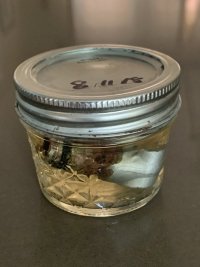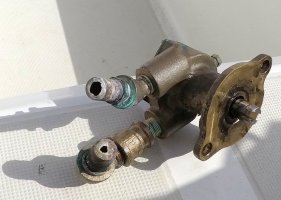-

Untitled Document The 2024-2025 Fund Raising Season has Opened!
EricsonYachts.org has opened the season for raising funds to support the expenses of the site. If you would like to participate, please see the link below for additional information.
Thanks so much for your continued support of EricsonYachts.org!
You are using an out of date browser. It may not display this or other websites correctly.
You should upgrade or use an alternative browser.
You should upgrade or use an alternative browser.
Seawater not pumping through engine
- Thread starter K2MSmith
- Start date
K2MSmith
Sustaining Member
My wife ( aka “the nuclear power plant design engineer - ret.” ) suggests that the L fitting may be flow restricted by design . The inside appears to be clean but inflow / outflow connected by a smaller hole inside. This is to prevent over pressuring the downstream component ( the elbow ) . So she said I should be cautious about putting any old fitting on it . ’mmmm
The fitting that came on my Yanmar mixing elbow is straight.
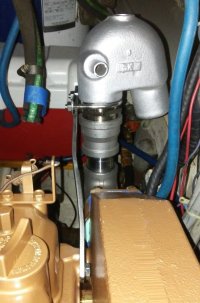
I don't think the hose fitting is a "designed" flow restriction. As water passes from the hose to the mixing elbow it enters a larger ID water jacket at the top of the elbow.
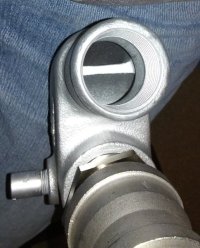
When the cooler seawater hits the hot exhaust elbow, it vaporizes and leaves behind mineral deposits. With an L-shaped hose fitting, much of this is happening at the bend in the fitting itself. That is where my OEM fitting was blocked.
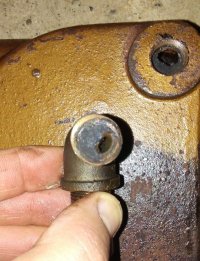
A straight fitting should clog less quickly, however that may just mean that more mineral buildup is occuring inside the water jacket.
If there is a design element to the L-shaped hose fitting, I'd guess that is it: To cause the flash-boiling and buildup to occur outside of the water jacket, in a fitting that is easily removable.

I don't think the hose fitting is a "designed" flow restriction. As water passes from the hose to the mixing elbow it enters a larger ID water jacket at the top of the elbow.

When the cooler seawater hits the hot exhaust elbow, it vaporizes and leaves behind mineral deposits. With an L-shaped hose fitting, much of this is happening at the bend in the fitting itself. That is where my OEM fitting was blocked.

A straight fitting should clog less quickly, however that may just mean that more mineral buildup is occuring inside the water jacket.
If there is a design element to the L-shaped hose fitting, I'd guess that is it: To cause the flash-boiling and buildup to occur outside of the water jacket, in a fitting that is easily removable.
K2MSmith
Sustaining Member
Conclusion: the L-fitting was clogged. Soaked in vinegar for 48 hours and then cleaned it with a bottle brush . An iPhone light is good for this task . Took about an hour to clean. You can shine light in one end and see how clear it is in the other . The fitting has no built in restrictions . It was narrowing due to the buildup . Reassembled everything and now I have 2-3 times water flow that I had before it clogged completely, but I didn’t know what was normal flow because I think it’s been partially clogged since I bought the boat . I’m looking forward to lower engine temperatures when I motor out next time .
Thank you all for your generous assistance and support. It is very much appreciated !
Thank you all for your generous assistance and support. It is very much appreciated !
Pete the Cat
Sustaining Member
A 5/16" socket works well on most hose clamps. I use a socket on the end of an electric screwdriver or compact drill driver. This speeds up the process a lot and makes it easy. This setup is cheap when compared to taking things to the boat yard. After 40 years, I have learned to invest in the specific tools for various jobs on my boats so that I am not reluctant to pull things apart and inspect and service them. It is also possible that you have a blocked connection to the exhaust elbow water injection site--the injection point in the elbow is vulnerable to clogs. Might be time to pull that off if problems coninue. Heat exchangers need regular service and exhaust elbows are meant to be inspected replaced periodically. Worked on mine today when replacing the zincs.Thanks for the info and thread Christian. That address for the radiator shop you used in LA (Blanco Brothers) looked familiar and as it turns out its just a few blocks from my mother-in-law’s house in Koreatown. The Drake tool looks like an oversized dental pick. Not sure how to use it, but it‘s cheap enough to order. (and all the tools I’ll ever need will cost must less than a trip to the marine diesel mechanic). You’re right about getting a small socket wrench..I ended up buying a small 3” 90 degree ratchet screwdriver wrench, but I think just a small 1/4 socket wrench would work better (which I don’t apparently have)... Add an LED headlamp to the list, especially with my poor near vision.

